
What is better than a blooming plant on the windowsill or the doorstep after a long period of snow and sub-zero temperatures?
Many growers are beginning to supply mixed containers of cool crops, where pansies are the main item
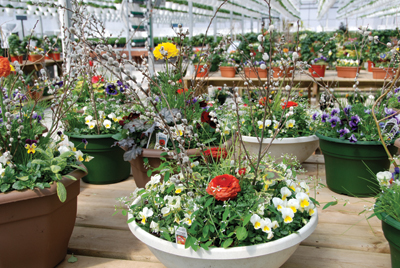 |
|
| An interesting cool crop combination. Advertisement
|
What is better than a blooming plant on the windowsill or the doorstep after a long period of snow and sub-zero temperatures?
Many crops can fulfil that desire for colourful, warm flowers of cool crops. Some of these plants are sold as pot plants throughout the entire season, including such as daffodils, tulips, and hyacinth. Others are sold as bedding plants to be planted in the garden. The reality in our climate is that nobody wants to play in the garden until mid- to late May due to the adverse weather. At the same time, many of us are anxious to see the signs of spring flowers. The answer to this desire is cool crops in containers.
For the last five to 10 years, the use of containers has increased
tremendously as a part of gardening and what is better than a container
to jump-start the gardening season and extend it, too?
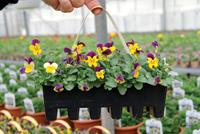 |
|||
| A viola pack. | |||
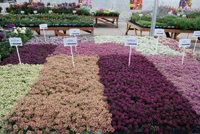 |
|||
| The different colours of alyssum; there’s something for everyone. | |||
 |
|||
| A flat of well-grown osteospermum. | |||
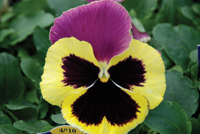 |
|||
| No, it is not a painted pansy. | |||
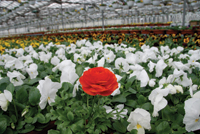 |
|||
| An amazing display by rananculas and pansies. | |||
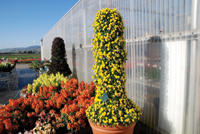 |
|||
| A viola tower is an attention-getter. |
|||
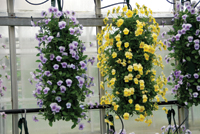 |
|||
| Viola wall bags put on an eye-catching show. |
|||
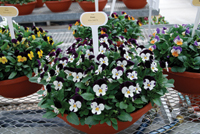 |
|||
| An impressive viola bowl. | |||
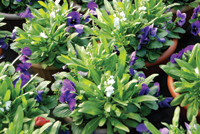 |
|||
| A pansy stock combination. | |||
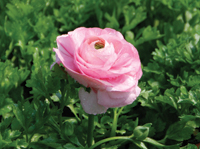 |
|||
| A rananculus flower.
|
The garden mums crop has increased over 1,000-fold since we started
producing them as a container garden for the fall rather than planting
in the garden. We did much better at marketing container mums in the
fall than the introduction of early cool crop containers in the spring.
Here are some reasons:
- Many growers still produce a 12-0-4 pansy that is supposed to be planted in a garden during the first few sunny days of late March/early April. However, the reality is that the weather is not co-operative long enough, and we are not ready to go and work the cold, semi-frozen ground.
- We try to sell what we think are cool crops, such as snapdragons, and other crops that can grow cold but cannot take -1ºC temperatures or don’t look very good. Therefore, we set up our customers to fail by buying a product for the wrong season or one that is not very appealing.
- The selling feature to an early spring crop is the colourful flowers. Many times, the cool crops we are trying to sell in the early spring don’t have any flowers. This is due to production difficulties due to the weather or a lack of knowledge.
- Growing the cool crops at high temperatures to meet a flowering sale date, and then shipping the product to be sold to customers who are going to place them in a very cool environment where the plants would not be able to handle the temperature shock. Cool crops have to finish cool before shipping so they can withstand cool temperatures.
MANY CROPS CAN BE GROWN FOR EARLY SPRING SALES
■ There are many crops that can be successful for the grower and consumer for an early spring sale. Included are alyssum, coreopsis, diascia, linaria, lobelia, bidens, mathiola (stock), nemesia, argyranthemum, bacopa, rananculas, osteospermum, primula, petunia and – the mother of all cool crops – pansy.
In my 31 years in the greenhouse industry, I have seen pansies produced in many different ways, including sowing in September, growing in the fall, and letting cool or freeze in the winter before thawing in the spring to be ready for sale.
Advantage: No energy cost.
Disadvantage: Dangerous production method, especially if thaw happens during winter and then freezes again. Also, the plants in the spring look old and tired, but tough.
Many growers now sow plugs in late November or early December and transplant in January and grow the crop at 4ºC until the sale date. Others transplant at the beginning of February, grow for one to two weeks at 15ºC, and then cool to 7-8ºC days and 10ºC nights. Then, when the crop is almost ready for sale, the temperature is cooled to 3-4ºC day and night.
The result is a fresh, active, hardened plant that will withstand cool temperatures but doesn’t look old and tired.
Few growers grow fast-crop pansy – that is a plant from a five-week-old plug put into containers for five weeks, grown at 17-18ºC temperatures and then shipped. The problem? You guessed it; these plants will not stand up to any cool temperatures at the store or for the consumer.
SUGGESTED PRODUCTION SCHEDULE
- Dec. 15 – sow in 512 with 18º-19ºC temperature.
- Dec. 18 – emergence A-Rest sprench 2.5 ppm, ease off the water, temperature of 18ºC day and night.
- Dec. 22 – fertilize with 14-0-14 or equivalent, with an EC of 0.75 and give all the light possible.
- Dec. 26 – allow soil to dry up between fertilization then fertilize with an EC of 1.0; 14-0-14, and temperature of 16ºC.
- Dec. 29 – make sure plugs are in an area of low humidity and high light and with a temperature of 16ºC.
- Jan. 3 – fertilize with 18-9-18 with an of EC 1.3.
- Some varieties might require growth regulator spray: Cycocel 1,000 ppm and B-Nine 1,500 ppm tank mix and temperatures of 15ºC.
- Jan. 6 – Jan. 30 – fertilize 14-0-14; EC of 1.5; keep on the dry side but not wilted; temperatures of 15ºC nights and 10ºC days; all the available light and low humidity.
- Feb. 1 – transplant.
Media – transplant into well-drained media of pH 5.5; this is very important and all soil media suppliers stock it.
It is important to note that, in my experience, using 12-0-4 packs will ensure you lose money. It is also bad for the consumer.
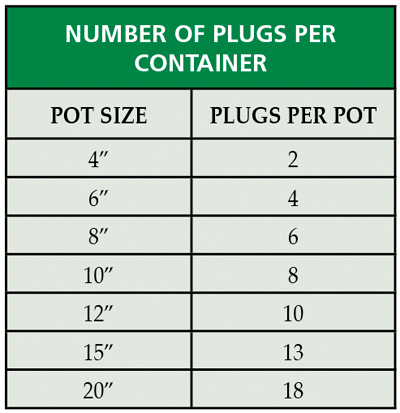
|
All sizes can be transplanted at the same date since the number of plugs adjusts with the pot size.
- Feb. 1 – Feb. 10: temperatures of 16ºC nights and 16ºC days.
- Feb. 10 – Feb 20: temperatures of 12ºC nights and 8ºC days.
- Feb. 20 – March 15: temperatures of 10ºC nights and 5ºC days.
- March 15 – sale date: temperatures of 5ºC day and night, if happy with the flowering stage.
If the number of plugs per container, plug culture, and growing program is followed, there will be no need for growth regulators.
Take soil samples to make sure levels are correct (mainly for pH) at:
- pH of 5.5 to a maximum of 5.8.
- EC levels are 0.6 to 0.8 (2-to-1 method).
- 1.2 to 1.6 saturate paste (lab test).
- Phosphorous levels of 8-12 ppm,
- but not lower or higher – adjust accordingly.
Aphid is the main pest. Scout and make sure you treat before blooms open.
Production sizes and percentages, as of last year:
- 12-0-4 – 15 per cent.
- 3-0-6 or 4” – 15 per cent.
- Bowls of different sizes – 70 per cent.
Some growers produce very few 10” hanging baskets, which doesn’t do anything to enhance the product as packaging. On the contrary, it makes them very unsalable.
Many growers are taking the initiative to supply mixed containers of the cool crops, where pansies are the main item, to make an excellent product. Trial some combinations and sell them at a premium price. Also, in addition to some of the cool crops we mentioned, there is a whole line of cool-crop filler to complement the combinations. Examples are the lasymicha (Goldylock), lamium, some English Ivy, and vinca vine.
The new breeding of the pansies and viola enable them to flower under higher temperatures than the old varieties. Selling the plants early spring and well into mid-summer is good value to the consumer. ■
Milhem Sawaya of Focus Greenhouse Management is a consultant and research co-ordinator to the horticultural industry. Comments on this or any other article are always welcome, please e-mail: mel@focusgreenhousemanagement.com, or visit www.focusgreenhousemanagement.com. To view photos from the previous two years of Sawaya Garden Trials, go to www.sawayagardentrials.ca.
Print this page